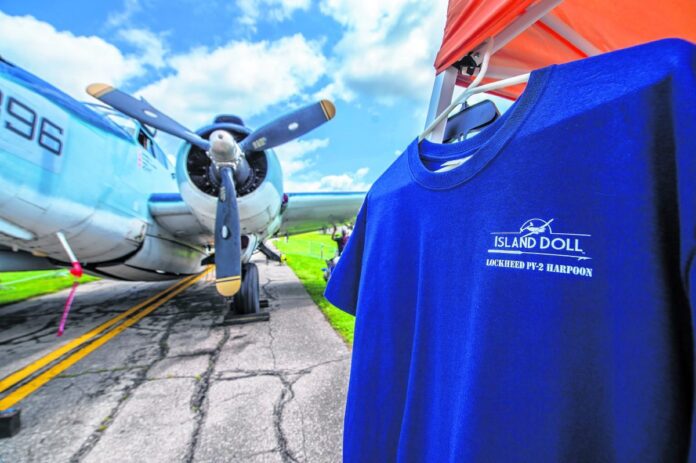
HANCOCK COUNTY — The World War II Navy bomber, built in 1945, now has a new name and a new mission.
The PV-2 Harpoon formerly known as “Hot Stuff” is now called “Island Doll,” and members of the American Military Heritage Foundation who care for the aircraft are working hard to attract younger members to the group who will commit to keeping it as a tangible artifact to be shared with future generations.
The past two weekends, members of the foundation have been camping out at Indianapolis Regional Airport in Mt. Comfort showing off Island Doll, which is kept at the airport. It was the first time since the pandemic that supporters have ventured out as a group and been able to showcase the plane, one of a dwindling number of World War II planes still capable of flying.
The group is trying to raise money for much-needed, costly maintenance, such as $7,500 to make sure the propellers on the twin-engine plane are functional, since it’s been almost a year since it was flown. Plus, the foundation members want to build a new hanger to house it, something that could cost over $1 million.
Richard Suiter, the foundation’s president, noted the aircraft sits outside year-round exposed to the elements. Parts are stored in a hanger several hundred yards away, making the proximity to work on the plane difficult.
Suiter said the foundation has had a rough year of fundraising, since they couldn’t show off the plane and solicit donations, which they use to maintain it.
“Last year, all the airshows got canceled, and so far this year they’ve been canceled, so we don’t really have any way to raise money other than word of mouth and coming out on weekends like this,” Suiter said.
That’s where newer and younger club members like Blake Shipp come in. He’s in his early 20s and brings new enthusiasm for the historic plane. He is bringing the group into the social media age and has created a digital business card through a platform called Popl that shares information on Island Doll.
Shipp, who studied engineering and aviation, is a recent graduate from Purdue University and currently works on submarine parts. He fell in love with Island Doll when he saw the plane at an airshow a few years ago. Now he’s spending his spare time learning all he can from the older club members who work on the plane about how to keep the aircraft airworthy. Shipp knows one day, he’ll be one of the engineers in charge of the plane.
“The older guys in the foundation who have been working on this plane for years know things about aviation and maintenance that can’t be taught in a classroom,” Shipp said.
However, Shipp knows things many of the club’s older members don’t, such as how to market fundraising and the foundation through technology. Visitors who stopped to see Island Doll last weekend might have seen Shipp showing off a Popl device that looked like a poker chip but was loaded with digital information about the plane that could be shared to a smartphone in about two seconds.
Shipp’s wife, Ann Shipp, is also a recent graduate. She studied history and also fell in love with Island Doll when she saw the old plane. She said such surviving relics must be shared, particularly with younger people.
“It’s a beautiful plane with a great story, and we want more people to know that,” she said.
The couple has plans to start shooting some videos about the Island Doll and sharing them on YouTube so they can reach a wider audience. They’re even considering showcasing maintenance work with the hope people will see all that goes into keeping Island Doll certified to fly.
The plane is said to be worth anywhere from $500,000 to $750,000 and requires a budget of thousands each year just to keep it functional and maintained. The Lockheed PV2-Harpoon was a bomber used mostly in the Aleutian Islands in the North Pacific during World War II. While the foundation’s plane didn’t see combat during the war, it was used in coastal training in the state of Washington and was a vital part of the Navy’s aviation campaign in the Pacific theater, club members said. Island Doll is one of only a few surviving PV-2s, which didn’t enter service until late in the war. Fewer than 600 were produced, and the local aircraft is one of three Harpoons still able to fly, according to the foundation’s website, amhf.org. By comparison, more than 12,700 Boeing B-17s — the backbone of the Army Air Forces in Europe in World War II — were built, according to the Boeing website.
As for the new name, Suiter said that happened a couple of years ago when foundation members looked at the older logo and thought some might consider “Hot Stuff” to be a little too risque. Plus, foundation members learned the name “Hot Stuff” belonged to another plane, a B-24 Liberator that crashed in Iceland in May 1943 on its way back to the United States after completing 31 missions. Out of respect, they changed the name.
The Island Doll logo, which still evokes the pin-up-style nose art painted on the sides of thousands of planes during the war, depicts a female figure with a harpoon poised in one hand.
“We moved the logo to the back of the plane instead of the front where ‘Hot Stuff’ was,” Suiter said. “We really like this one much better.”
[sc:pullout-title pullout-title=”How you can help” ][sc:pullout-text-begin]
People interested in donating to support maintenance for the Island Doll may visit its website, www.amhf.org or www.islanddoll.org. Those interested in learning more can also sign up for email updates.
[sc:pullout-text-end]




